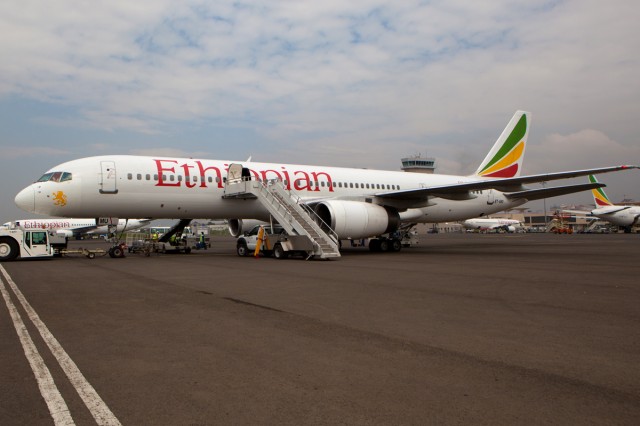
Ethiopian Airlines Boeing 757-200 at Addis' Bole International Airport. Photo by Jeremy Dwyer-Lindgren / NYCAviation.
Previously I shared a review of Ethiopian Airline’s Cloud Nine Business class, written by Jeremy Dwyer-Lindgren for NYCAviation.com. This is his second review, which looks at Ethopian’s economy class. Here is his review in his own words…
WASHINGTON DC: Four flights, forty-four hours of flying, and one day trip to Ethiopian Airlines headquarters in Addis Ababa later, NYCAviation (NYCA) has one good story ready to roll. Over the course of the next month, NYCA will be debuting a three part series focusing on the Ethiopian carrier; their in-flight service, their history, and their future. We hope you’ll join us for the adventure!
The first in the three part series, NYCA reviews the in-flight experience in the economy cabin on board Jo’Burg to Addis and Addis Ababa to Dulles flights. Both flights were inaugurated during the mid to late 1990s as part of an aggressive expansion of their international service surrounding their 50 year anniversary (1996 and 1998, respectively). Ethiopian provided the flights to NYCA at no charge, flying both legs in September 2011.
Part I Jo’Burg to Addis
Ethiopian Airlines Flight 808 Service to Addis Ababa from Johannesburg
Boeing 757-200 ET-AMT or AMU
Dep: 1438/SAST Arr: 2030/EAT
Seat 15A: Economy Class
Having been dropped off from a previous flight in the domestic terminal in Johannesburg, finding the international check in desks was a bit of a chore. Once located, the line had built up to a forty minute wait, despite not having a bag to check.
Once ticketed, customs and security were both very straightforward and easy. The inbound flight from Addis was running late, and I spotted an Ethiopian Boeing 757, not the listed Boeing 767, rolling to a stop on the runway about twenty minutes prior to boarding time. Nevertheless, boarding began only eight minutes late at 1348 local time, and I settled into 15A for the five hour flight north to Addis Ababa. My carry-on has no problem finding a home, and the camera comes out for departure. The 757 being the performer that it is, we rocket nicely out of Johannesburg about 32 minutes behind schedule.
Considering the 757’s are some of the older aircraft in a fleet that is otherwise unusually young, the quality of the cabin is remarkably good. All the economy seats are (p)leather clad and comfortable enough for economy. They recline a workable 32 degrees of pitch and feature a built in remote in the armrest for selections of music or movies. However, it was odd that the armrest did not lie flush with the seat when not reclined. It stuck out a healthy amount, enough so that if you were lucky enough to have a seat vacant next to you (as I did) it becomes hard to stretch out without getting poked by it.
This particular aircraft was not outfitted with personal TV’s but did have the screens that are fixed to the cabin ceiling. The programming began about 45 minutes in with the smaller shows through dinner culminating to the movie about three hours in.
A meal & drink service began about an hour into the flight presenting options of chicken or fish. The meal consisted of chicken breast with a tomato sauce, rice and carrots. A roll with butter, crackers & block of cheddar cheese, salad with Greek dressing, and packaged desert of coconut cheesecake with berry sauce complimented the main dish. Overall it was a serious step up from anything you’d get domestically in the US nowadays, but it was not ultra fantastic either. It was satisfying, filling, warm & good. The meal was followed up by traditional post meal coffee and tea service. Trays were cleared about an hour following dinner, which appeared problematic for many of the other passengers, since most were done within twenty minutes.
While not watching the movie most of the flight was spent sleeping or talking up the staff in the rear galley. Speaking of the staff, there were some noteworthy exchanges. For the first, I attempted to inform a flight attendant, who throughout the whole flight never gave the impression that she was thrilled to be on board, that one of the lavatories had an issue needing attention ’“ I never received a response. On the flip side, I had some questions about how customs and the process in general worked once arriving in Addis. I inquired in the rear galley and all three flight attendants were extremely helpful in answering each and every question in addition to pouring me a few drinks. The one attendant aside, the staff met or exceeded expectations for friendliness and professionalism. I wish I had more pictures from this flight, but unfortunately the vibe was not right for it, so the camera stayed put away through most of it.
Despite the late departure we made up the time in the air and ended up landing ten minutes early; a nice surprise. After waiting for Cloud Nine business class passengers to vacate, we de-boarded via the air stairs and onto large busses that took us the short distance to the terminal.
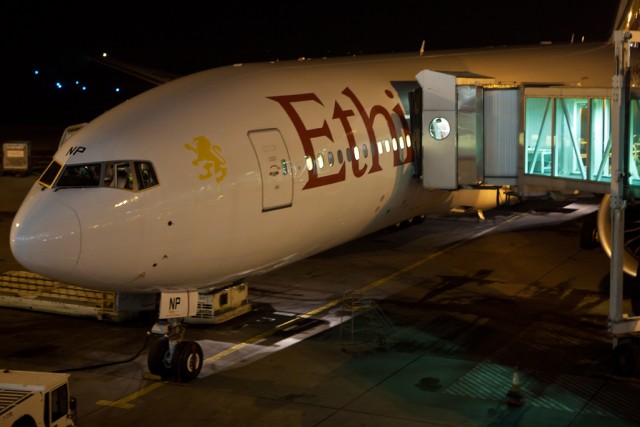
Ethiopian Boeing 777 in Addis. Photo by Jeremy Dwyer-Lindgren / NYCAviation.
Part II Addis to Washington Dulles ’“ Via Rome
Ethiopian Airlines Flight 500 Service to Washington Dulles from Addis Ababa via Rome
Boeing 777-200LR ET-ANO
Dep: 2227/EAT Arr: 0300/CEST // Dep: 0801 Arr: 1117
Seat 23A: Economy Class
Arriving at the ticket counter around seven at night after a long day, it was relieving to see a ticket counter dedicated solely to the flight. Check-in was smooth and fast, with customs and security following the pattern. At 2130 the flight begins to board, and twenty minutes later I settle into 23A for seventeen hours aboard the brand-spanking new Boeing 777-200LR (ET-ANO). Despite a scheduled departure of 2205, we did not end up pushing from the gate until 2216, with wheels up for Rome at 2227. Twenty minutes is not the end of the world though, and we predictably made it up en route while trekking over Sudan, Egypt, and the Mediterranean.
Much like the prior flight from Addis to Jo’berg, the first meal service promptly began about an hour in. We were offered choices of chicken, beef, or fish. I chose chicken. It was bathed in a cream sauce along with rice and carrots. A side salad, crackers & cheese, and a roll with butter were also provided. The meal was of average quality and filling. It might have been better – or I might have been a better judge – had I not had a nasty head cold that developed from the day before. As a result, my sense of taste was not in its best form.
While waiting for the dinner tray to be cleared I spent some time playing BlackJack on the 777’s seat back entertainment system. It was clear that Lady Luck was not with me, as I burned through my 1000 in fake money in what may have been a new airline record. Shortly after, while starting a movie, the entertainment system froze and then shut down completely. My seatmate had the same problem, and flagged down a flight attendant who attempted to rectify the problem. About thirty minutes later the system restarts and is fine for the remainder of the flight. Most of the rest of the first leg is spent asleep.
We touched down in Rome almost twenty-five minutes ahead of schedule at 0300. A short taxi later we’re in position on a remote ramp for a refuel. Most of the cabin is asleep, watching a movie or reading a book, and no one seems to notice that the hour scheduled stop has come and gone. About ninety minutes into the stop the pilot announces that we’re still taking on fuel and it’ll be another hour: plus some tires have ’œlow pressure’ and need to be replaced. Frankly this sounds fishy to me, low pressure in the tires does not normally require replacement unless they were totally flat, but maintenance is what it is and at this point complaining is not going to get me off any faster. Another hour later the jack for the tires arrives and it is not large enough. The correct one does not arrive for another ninety minutes or so. By the time the plane has been refueled (twice by the pilot’s record) and fixed up with new tires the stop in Rome lasts just over five hours: No fun.
That being said, the airline and the flight crew did a great job of making an unfortunate situation tolerable. Consider: the plane was kept cool, powered, and the entertainment functional the entire five hours. The crew completed a meal service (I’m told it was breakfast, feeling pretty awful I slept through it), and offered drinks the whole time. And they kept smiling to boot ’“ impressive. We finally set off for Rome four hours behind schedule, with wheels up at 0801 local time.
Cutting to the product itself, the seat-back entertainment is quite nice. The on-demand offerings ranged from TV to games, flight maps to movies. The screen can be operated by touch or by a remote built into the armrest. The seat reclines to 32’ of pitch, and also pushes out to decrease the amount of recline into the person behind you’s space. The plus side is the passenger in front of you takes up less of your space’¦the downside is you reduce your leg room by pushing the seat out. The trade-off seems worthwhile to me.
The airplane being new (the average age of the 777 fleet is under one year), the cabin is predictably in great shape and the newness of the airplane impresses a lot of travelers. The 3-3-3 setup feels reasonably spacious, despite the cabin being full to the brim (287 folks on board).
The remaining nine and some change hours en route from Rome were largely spent sleeping and catching a few movies. Still feeling rather ill, I declined brunch except for a ginger ale, though the food of my seatmate appeared to be similar in nature to the late night dinner we had some twelve hours earlier.
We greased the runway at Dulles at 1117 local time and pulled up to the gate quickly. Deboarding was a bit chaotic, but with a little planning I ended up being first off those annoying Dulles customs shuttles, allowing for a quick sprint through customs and back into the good ole U S of A.
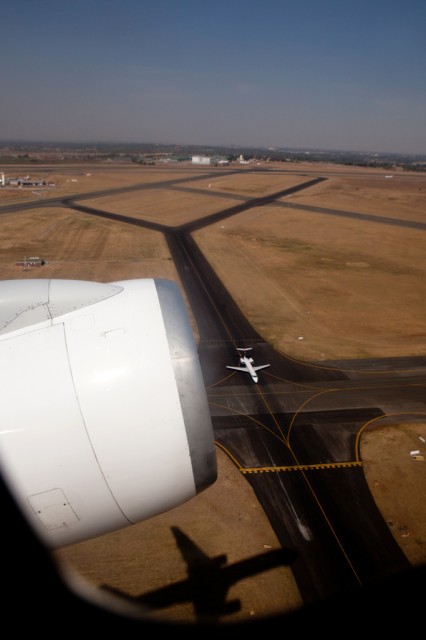
Departure out of Johannesburg. Photo by Jeremy Dwyer-Lindgren / NYCAviation.
Part III The Bottom Line
Regarding Flight 808 to Addis, it was a slightly above average economy experience. The service and staff were generally friendly and fast, the food was good, and the seat on par for an economy experience. Personal entertainment systems, like a seat back system, would have been a bonus, but the five hour flight is not terribly long: bring a book or an e-reader if you need some help passing time or utilize the in-flight entertainment. When compared against most US domestic economy sections, this flight comes out looking good. With the variance on plane types for the flight, you might even be treated to an oversized Boeing 767.
Moving on to Flight 500, let’s cut right to it: seventeen hours on an aluminum tube in coach is never going to be a picnic no matter the carrier. And even worse when an unexpected delay pushes it to twenty-one straight hours.
Addressing the delay, a five hour ground stop for fueling and tire replacement seemed excessive, but this is also a moment that forces an airline and a crew to show their true colors. In this respect Ethiopian met or exceeded expectations: they kept the plane powered & cool and the PTV’s running, they completed a food service, and they kept drinks available through the entire stopover; with a smile. What could have been a nightmare worth writing home over instead turned into an opportunity to show off the airline and crews ability to manage a stressful situation and make the best out of it.
The vast majority of the time, however, the flight will not experience a similar delay and by and large customers will find an enjoyable economy experience. Friendly service, plentiful & decent hot meals, and a well stocked entertainment system help the scheduled seventeen hour flight go by fast.
Overall, while other reviews online are not especially positive, this traveler had a markedly pleasant experience on both economy flights even with the five hour delay in Rome factored in. When you consider prices that the carrier has recently offering on the flights, it is an option that is hard to pass up. This author feels that most travelers will find themselves pleasantly surprised and that coach travelers can rest assured that they will be kept comfortable and well fed on board Ethiopian economy.
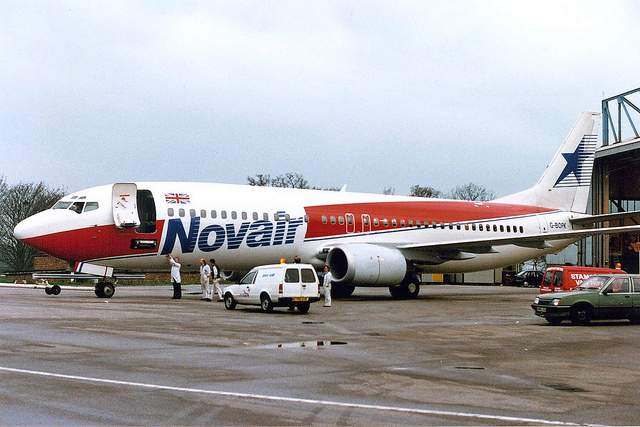
Click to see larger. Photo by Ken Fielding.
AirlineReporter.com reader and airline enthusiast Ken Fielding , who has already brought us great photos of a Boeing 767 with its door open and a Lockheed Constellation that tipped over, now shares a story and a series of photos of a Novair brand spanking new Boeing 737-400 that had some issues trying to get into a hangar in Manchester. Here are his photos and story in his own words:
When Novair took delivery of their two -400’s in spring 1989, they contracted out the line and base maintenance to Dan-Air Engineering in Manchester (MAN). Unfortunately the Dan-Air hangar at Manchester wasn’t quite high enough to accommodate the taller tail on the B737-400… so what did they do? The next few photo’s show how they did it…
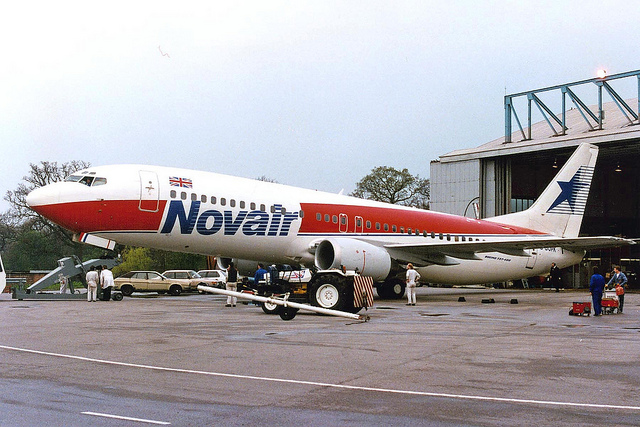
Click to see larger. Photo by Ken Fielding.
They designed a hydraulic tow bar which could lift the nose of the aircraft and therefore lower the tail enough to be able to get it through the hangar doors.
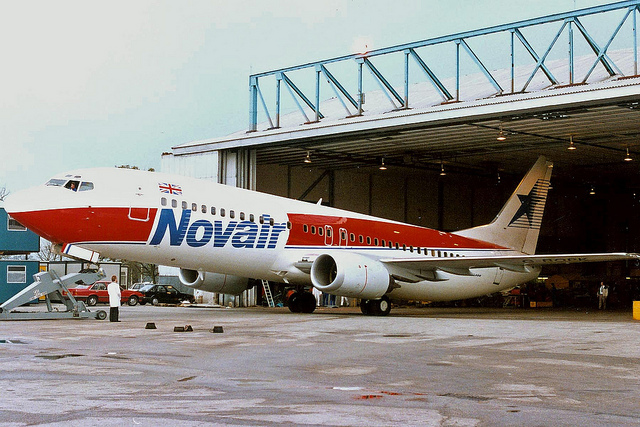
Click to see larger. Photo by Ken Fielding.
It required a delicate balancing act to ensure that the tail didn’t hit the ground, then push it gently backwards. It was the first time this had been tried on a ‘live’ aircraft so everyone held their breath as it continued to move slowly backwards.
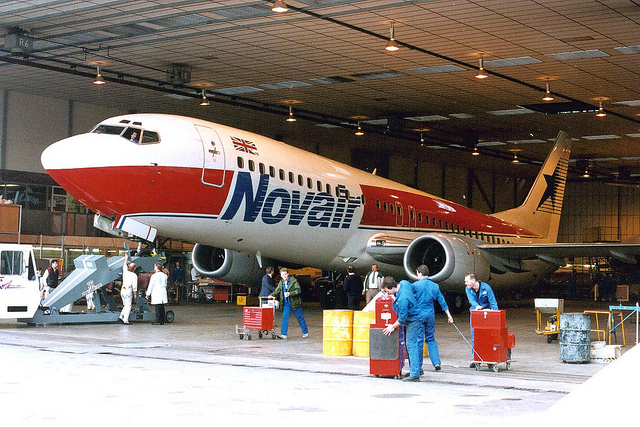
Click to see larger. Photo by Ken Fielding.
Almost in position. They had even remembered to cut a hole in the hangar ceiling to accommodate the top of the tail when they let the nose down again.
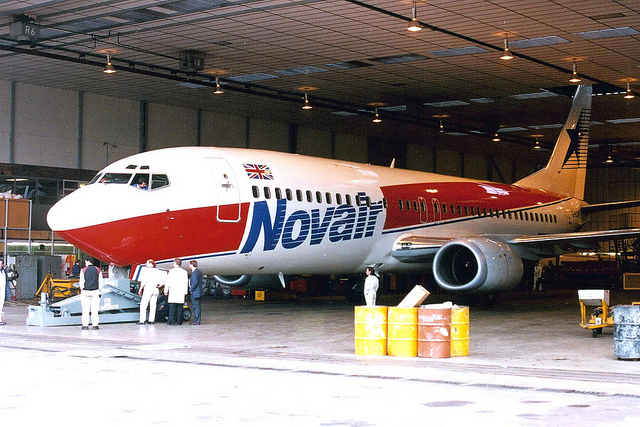
Click to see larger. Photo by Ken Fielding.
And there we are, in position at last! It all happened in reverse to get it out again.
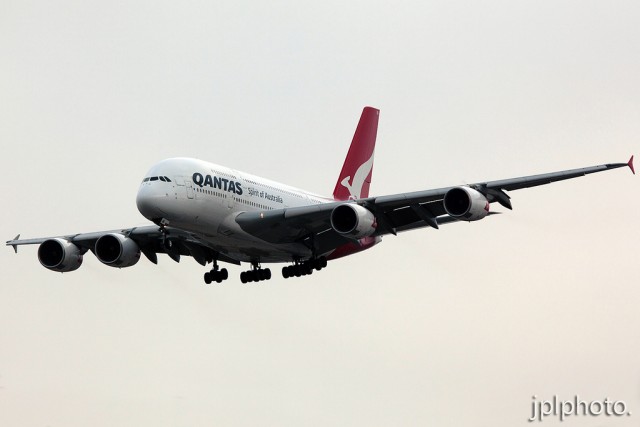
Qantas Airbus A380 landing at LAX.
Getting on a plane with-in the US that offers in-flight internet is not that rare anymore. Many airlines have their entire fleet outfitted and others are still in process. For some, having access to the internet for a flight that might only last a few hours is not a huge perk — yet, there is surely more demand for flights that are longer. Since most US-based in-flight internet makes use of cell towers on the ground, the service is not available for international flights. Satellite based systems are heavier, cost more and take longer to install. Because of this, we have not yet seen a many airlines that offer Wi-Fi on longer, international flights.
Even though there have been quite a few airlines that have announced their intent to provide satellite internet service, many have not followed through for one reason or another. One airline that is moving forward with long-haul internet is Qantas.
Qantas Airlines decided to use OnAir as their service provider and they currently have six of their Airbus A380 aircraft flying between Australia and the US configured to offer Wi-Fi on an eight week trial.
’œThe eight-week trial will give customers the opportunity to access the Internet in exactly the same way as a terrestrial Wi-Fi hotspot in which customers can pay with their credit card and surf the Internet, including the use of email,’ Qantas Executive Manager Customer Experience, Alison Webster, said.
Since this is a trial run, only passengers in premium cabins (first and business) will have the opportunity to try out the OnAir Wi-Fi. After the two months is up, Qantas, “will assess opportunities for the long-term application of Internet capabilities across its A380 fleet.”
Australian Business Traveler (AusBT) was able to get a first hand account on how the new Wi-Fi service works. They tell the story of Andrew Hazelton, who flew on February 29th and was given 35MB of bandwidth to use during his flight. That is not much, especially for a long flight and Hazelton told AusBT that he used all of his bandwidth quickly and he was not super impressed by the slow speed of the service. Of course, this is just a trial period and it is hoped that speeds will improve with time.
During the trial, the internet is free for first class and business class passengers and Qantas and OnAir are in process of figuring out how much they might want to charge for the service, if the trials are successful.
Besides testing satellite internet, Qantas is also working with aircraft based entertainment, accessed through Wi-Fi. The new service, called Q Streaming, allows customer to wirelessly connect to computers on the aircraft to access an array of in-flight entertainment options.
See a video played on the Q Streaming aircraft to let passengers know they are on a special aircraft
Passengers have high expectations and I feel that in the next year or so we will see more airlines adding the ability to access Wi-Fi on international flights. It might not be the best quality of service, but with additional development, we will all see quicker and cheaper options.
Image: Jeremy Dwyer-Lindgren
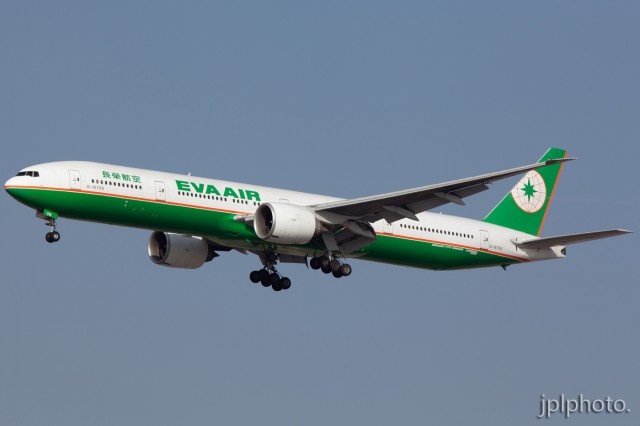
EVA Air Boeing 777-300ER.
EVA Air is an airline based in Taiwain and was founded in 1989. They started flight operations on July 1, 1991 and today they fly to over 40 international destinations.
The airline has mostly an all wide-body fleet of aircraft including the Airbus A330, Boeing 777 and the Boeing 747. They also have a small fleet of MD-90 aircraft.
The airline has a unique livery using green and orange. The green represents durability and the orange represents technological innovation. According to Wikipedia, “The tail globe logo is intended to represent stability and reliability, and its positioning on the tail, with one corner off the edge, represents service innovation.”
I feel that the livery is beautiful and best appreciated in person. I have heard from some that they aren’t as much of a fan of the orange and green, but you do not find many airlines showing off green and especially with orange. The previous generation of livery still had the green and orange striping, but had a bit too much white.
Image: Jeremy Dwyer-Li ndgren









